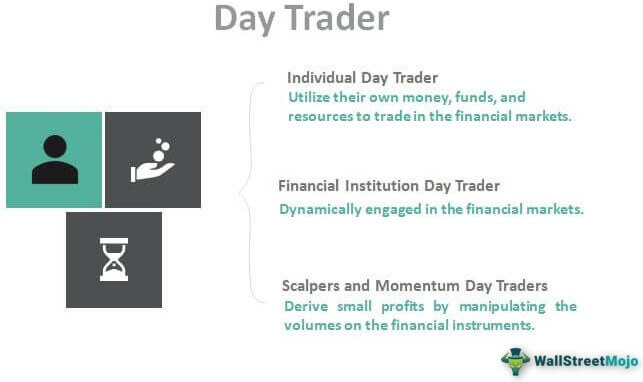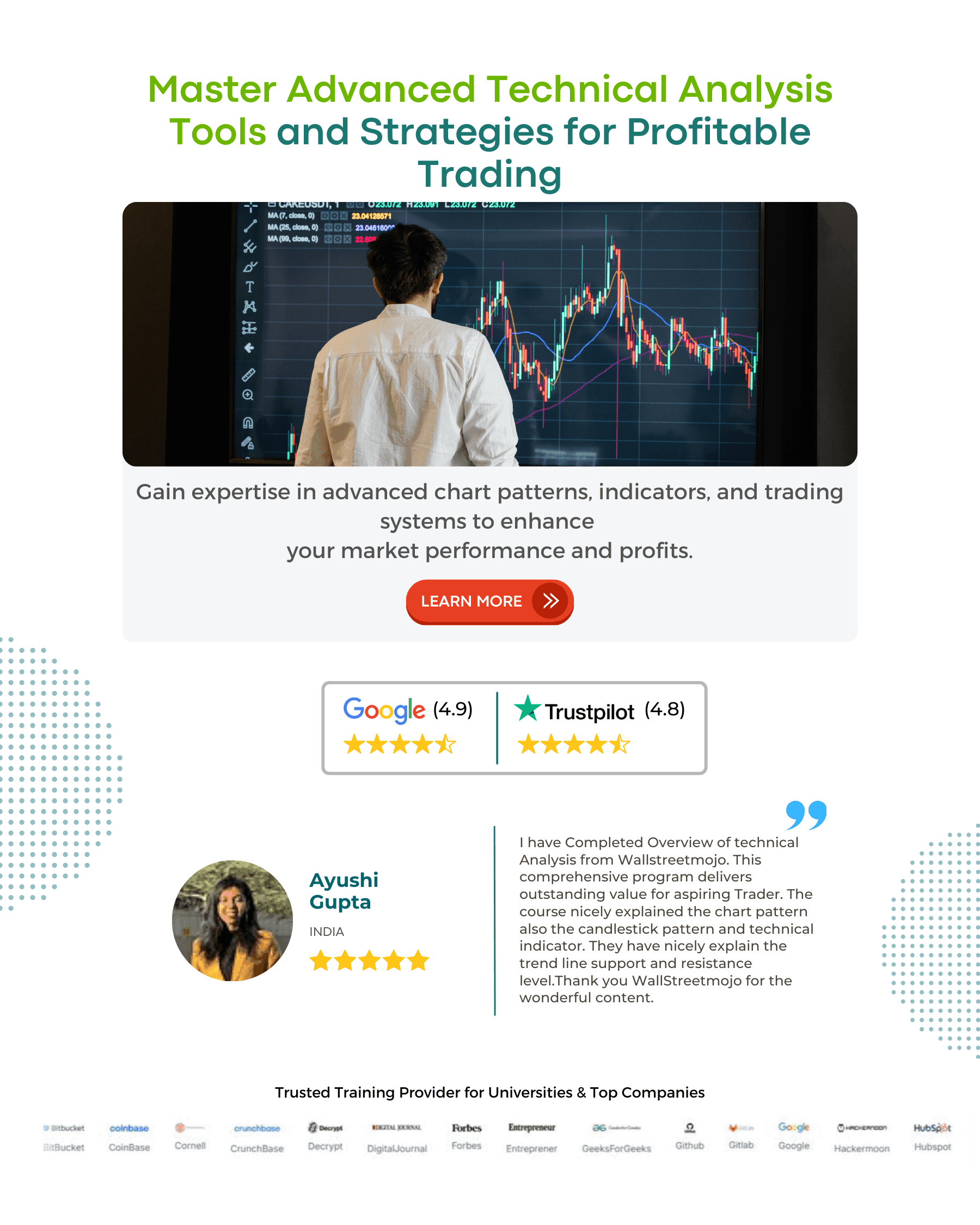Table Of Contents
What Is A Day Trader?
A day trader is an individual who trades in the financial markets daily to earn profits by exploiting the opportunities present in the market. These traders purchase and sell securities within the same day in an attempt to book profits within the same trading session. However, it is significantly riskier than other forms of trading.

Day trader stocks can be found efficiently by players in the market who have more experience and technical knowledge about the intricate details of the market and sometimes even have the access to information that the retail investors might have. However, it is important to understand that with all the knowledge and access to information, they take calculated risks to make gains.
Table of contents
- A day trader is an individual who trades daily, unbothered by the market inefficiencies going on currently. There are three types of traders; financial traders, individual traders, scalpers, and momentum traders.
- Day trading features the size of capital, trading strategies, technical analysis, and the trading platform it is being conducted. They are important in decision-making for such traders.
- Such a trading method is beneficial as it provides a good attention span and a dynamic stance; any sudden bolts in the market stay at bay for day traders.
- There are a few disadvantages of this role, such as higher commission costs, marginal profit-making is temporary, and such a trader has limited funds and resources.
Day Traders Explained
A day trader is an investor in the market that purchases and sells securities within the same day or within a trading session to make gains in the short term. It is riskier in comparison to the conventional form of investing for the long term.
The performance of the day trader options is always limited by transaction costs, commissions, dynamic changes in the bid-ask spread, and any expenses borne by taking up automated trading software.
There may be a situation wherein the trades performed by the trader may not provide any substantial gains since there may be limited volumes or less liquidity along with reduced price volatility in the financial markets as a whole.
Types
Let us understand the different types of day trader stocks and other details about these players in the market through the discussion below.
#1 - Individual Trader
They are the ones who utilize their own money, funds, and resources to trade in the financial markets. They may trade on instincts or trading strategies devised by them. However, an individual trader with a proven track record of implementing successful strategies and delivering good returns may also handle individual high net worth accounts.
#2 - Financial Institution Trader
The financial institutions are dynamically engaged in the financial markets. They have separate departments under their ambit that undertake strategies to squeeze some money out of the financial markets on an intraday basis. They, therefore, hire individuals who specialize in day trading.
All the necessary resources and funds are allocated to the day trader. Financial institutions hire them to utilize the resources to provide returns to the financial institutions.
#3 - Scalpers and Momentum Traders
Scalpers are defined as individuals who derive small profits by manipulating the volumes of financial instruments. Finally, momentum traders are those who devise trading strategies based on the current market sentiments, trends, and momentum inherent in the financial markets.
Features
There are multiple features that comprise and form day trader stocks. Let us understand the features or components of this facet of the market through the explanation below.
#1 - Size of Capital
A day trader who is at beginner levels may have limited capital to undertake. Therefore, trading capital can be defined as the resources and funds held in hand to be employed specifically for trading purposes. Consequently, they have to adapt to careful planning and strategy to best use their resources.
#2 - Trading Strategies
Each one has the trading strategies that it may use to manipulate inefficiencies in the financial markets and derive profits from them. Some of the strategies are based on the traders' technical analysis, trends, and guts instincts.
#3 - Technical Analysis
Technical analysis is defined as analyzing the price movements of the financial assets present in the financial markets. They analyze the upward and downward trends in the markets to predict the best price to enter or exit the financial markets. There are many tools such as moving averages and charting methods that help the day traders devise a comprehensive trading strategy.
#4 - Trading Platform and Highspeed Internet
They utilize high-speed internet and engaging high-end trading platforms to drive fast intraday positions. Due to exponential improvement in technology and the advent of the information age, there has been an emergence of discount brokers who charge zero brokerages simultaneously and provide high-end optimized trading platforms that help the day traders to drive trades. They take up the services of discount brokers and try to gain small profits from the intraday positions.
Examples
Let us understand the concept of day trader options and other deeper layers of this concept through the examples below.
Example #1
Steven, a day trader has taken a long intraday position in ABC stock at 10 am. The price of entry is $15.
At 11 am, the price of ABC reaches the level of $25 per share. The trader squares off his position at $25 to earn a gain of $10 per share. The trader would then pay $3 towards the transaction costs and commissions for facilitating intraday trades.
After deducting the costs, the trader's net gain is $7 per share.
Example #2
During the COVID-19 boom in the stock markets across the globe, investors wanted to jump onto the bandwagon and make the most of the boom and book profits in a short span of time. As a result, investors have been losing a staggering $358,000 every day in the stock market, says a University of Muenster study.
These trades are referred to as 0DTE or Zero Days To Expiration. New investors in the market have struggled to make it work in their favor and have lost over a billion dollars in a desperate attempt to figure out the metrics.
The concept is easy to understand with the help of a suitable chart from TradingView, as given below. In the chart of HCL Technologies, a channel is visible that is on a downtrend. It is an hourly chart, which is most suitable for day traders. The candles with the channel are hourly candles, that is clearly showing that the stock is creating lower highs and lower lows every hour.
But for the last two sessions within the channel, there are two bullish candlestick that suggest that there might be a positive breakout very soon. In that case, the trader may enter the market with a long position and aim for a target profit at the 1150 price level, which has been the week’s high before it started to descend. It is, however, necessary to have a stop loss in place because the price movement may take place in the opposite direction, quite contrary to what the trader anticipated. As given in the chart, stop loss can be at the 1118 price level, which has been the week’s low.
Overall the stock has shown a good positive trend during last week but it has opened with a gap down in the current week. Therefore, the trader should be carefull and keep track of any changes through continuous monitoring, not only related to price movement but also any current news.

Rules
Regardless of the fact that the same set of rules would never work for all traders or day trader stocks in the market, these can be considered as guidelines before entering into such traders.
- Traders should set realistic targets for themselves to ensure not getting carried away by the movements in the market.
- To limit the risks in the already risky activity, it is usually advised to avoid penny stocks as they are more volatile and hence, riskier options to trade.
- It is also better to set aside an amount to trade within the same day as investing the whole amount set aside towards growth can be at risk through such trades.
- Understanding the market emotions and small movements in the overall emotion in the market could be of great help as markets move according to them more often than not.
- Constantly learning new metrics and methods of technical and fundamental analysis will always help us understand this art and science better.
Advantages
Let us understand the advantages of picking the right day trader stocks and booking profits in the short run through the explanation below.
- Since they maintain intraday positions, their returns are not harmed by any news overnight.
- A specialized day trader can always analyze his current position in the financial markets and trigger stop-loss functions at critical junctures to reduce and mitigate any potential losses arising out of the positions undertaken.
- There is the presence of individual brokerage houses that tend to provide extensive margins and leverages, which can then be used to leverage them to derive good profits and returns.
- Due to the vast uncertainties in the financial markets, day trading has become a very dynamic job. Due to this inherent nature, they learn something new daily.
- The day trader having a good attention span with a perfect grip on technical analysis skills can earn high returns on intraday positions.
Disadvantages
Despite the various advantages mentioned above, the very fact that it is riskier than other options cannot be ignored. Let us understand the disadvantages of day trader options and other such options in the market through the points below.
- The trader who performs two to four trades daily also bears higher commission and transaction costs.
- There are certain types of assets on which day trading cannot be completed and hence becomes out of scope for the day trader itself.
- If positions are derived using margins, then there is a high probability that the trader may incur huge losses on such positions.
- There would be a situation wherein the trader may not get enough time to manipulate the positions undertaken and hence may not be able to derive returns on such positions.
- An individual trader who is new to day trading would have access to limited funds and resources.
- An inexperienced trader may lack the understanding of technical analysis techniques.
For professional-grade stock and crypto charts, we recommend TradingView – one of the most trusted platforms among traders.
Disclosure: This article contains affiliate links. If you sign up through these links, we may earn a small commission at no extra cost to you.
Frequently Asked Questions (FAQs)
Day trading is not always beneficial. For example, intraday traders make specific errors in judgment by not doing proper research, following up on personal predictions, and making baseless recommendations.
As the most crucial rule of day trading, the trader should never hold onto to position after closing the market, whether they earn a profit or not. Based on overnight news, a stock may increase or decrease, resulting in more significant trading losses for stockholders.
Any day trader needs to covet the skill of ‘technical analysis. It is a sort of pseudo-equity research wherein the trader understands the day-to-day opportunities provided by the overall market that day and notes the movements of the stock prices.
Recommended Articles
This has been a guide to what is a Day Trader. Here we explain their rules, types, features, examples, advantages, and disadvantages in detail. You can learn more from the following articles –

